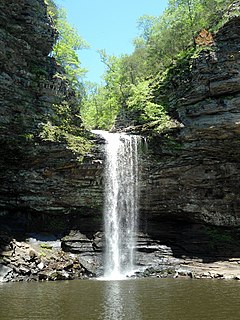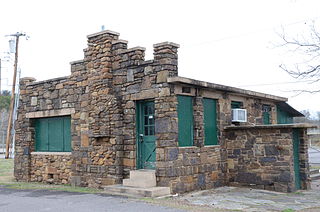
A motel or motor lodge is a hotel designed for motorists and usually having a parking area for motor vehicles. Entering dictionaries after World War II, the word motel, coined as a portmanteau contraction of "motor hotel", originates from the Milestone Mo-Tel of San Luis Obispo, California, which was built in 1925. The term referred initially to a type of hotel consisting of a single building of connected rooms whose doors faced a parking lot and in some circumstances, a common area or a series of small cabins with common parking. Motels are often individually owned, though motel chains do exist.

Cave City is a city in Independence and Sharp counties in the U.S. state of Arkansas. The population was 1,904 at the 2010 census. The city was named for a large cave underneath the Crystal River Tourist Camp, which is the oldest motor court in Arkansas. Cave City is known for its award-winning "world's sweetest" watermelons and holds an annual watermelon festival in July.

The Ozarks, also known as the Ozark Mountains or Ozark Plateau, is a physiographic region in the U.S. states of Missouri, Arkansas, Oklahoma and the extreme southeastern corner of Kansas. The Ozarks cover a significant portion of northern Arkansas and most of the southern half of Missouri, extending from Interstate 40 in central Arkansas to Interstate 70 in central Missouri.

Petit Jean State Park is a 3,471-acre park in Conway County, Arkansas managed by the Arkansas Department of Parks and Tourism. It is located atop Petit Jean Mountain adjacent to the Arkansas River in the area between the Ouachita Mountains and Ozark Plateaus.

Lake Hamilton and Lake Catherine are a pair of man-made lakes around Hot Springs, Arkansas. The two lakes have greatly improved the tourism in Hot Springs. Both Lakes were created by Arkansas Power & Light.
U.S. Route 66 is a former east–west United States Numbered Highway, running from Santa Monica, California to Chicago, Illinois. In Missouri, the highway ran from downtown St. Louis at the Mississippi River to the Kansas state line west of Joplin. The highway was originally Route 14 from St. Louis to Joplin and Route 1F from Joplin to Kansas. It underwent two major realignments and several lesser realignments in the cities of St. Louis, Springfield, and Joplin. Current highways covering several miles of the former highway include Route 100, Route 366, Route 266, Route 96, and Route 66. Interstate 44 (I-44) approximates much of US 66 between St. Louis and Springfield.

The Rising Sun Auto Camp, also known as the Roes Creek Auto Camp, East Glacier Auto Camp or simply Rising Sun preserves a portion of the built-up area of Glacier National Park that documents the second phase of tourist development in the park. Rising Sun is located along the Going-to-the-Sun Road, approximately 7 miles (11 km) from the east entrance to Glacier National Park, Montana, United States. Rising Sun is a wayside area that has a National Park Service campground, a camp store and gift shop, picnic area, restaurant, as well as a motel and guest cabins which are managed by the park's concessionaire, Xanterra Parks & Resorts. In the immediate area, there is also a boat dock as well as sightseeing boats which allow visitors to tour Saint Mary Lake, the second largest lake in the park. "The most popular spot for [Glacier] tourists is Rising Sun, an overlook of Goose Island in St. Mary Lake and one of the most photographed spots in the park."

The Blue Bonnet Court, originally called the Bluebonnet Tourist Camp, is a historic motor court-style motel in north-central Austin, Texas. It is located at 4407 Guadalupe Street, Austin, Texas.

U.S. Route 62 is a U.S. highway running from El Paso, Texas northeast to Niagara Falls, New York. In the U.S. state of Arkansas, the route runs 329.9 miles from the Oklahoma border near Summers east to the Missouri border in St. Francis, serving the northern portion of the state. The route passes through several cities and towns, including Fayetteville, Springdale, Bentonville, Harrison, Mountain Home, Pocahontas, and also Piggott. US 62 runs concurrent with several highways in Arkansas including Interstate 49 and U.S. Route 71 between Fayetteville and Bentonville, U.S. Route 412 through much of the state, U.S. Route 65 in the Harrison area, and with U.S. Route 63 and U.S. Route 67 in northeast Arkansas.

Woodland Courts is a collection of tourist cabins in Hardy, Arkansas. They are located along Dawson Street, between Echo Lane and Springwood Street. They are ten vernacular wood frame structures finished in a fieldstone veneer, with a gable roof. They are generally oriented to face east, regardless of their position with respect to the street. They were built c. 1938, and are the oldest surviving tourist facilities in Hardy, which had become a noted regional tourist area by the early 20th century.

The Merle Whitman Tourist Cabin is a historic traveler's accommodation at 200 North Bell Street in Ozark, Arkansas. It is a distinctively styled vernacular structure, built out of local fieldstone, cut sandstone, and concrete. Built in 1933–34, it is the only known tourist building in Franklin County using this combination of materials. It was used as tourist accommodation until the 1960s, when it was purchased by the United States Army Corps of Engineers as part of land taking for the Jeta Taylor Lock and Dam project. It housed the offices of the local chamber of commerce between 1966 and 1995.

The Cottage Courts Historic District encompasses a historic travelers' accommodation at 609 Park Avenue in Hot Springs, Arkansas. Built about 1950, it was one of the first motel-type tourist accommodations to be built in the city. Unlike earlier tourist courts, which typically had idiosyncratic vernacular architecture, Cottage Courts consists of two ranch-style single-story buildings, one of which houses twelve guest rooms, and the other three plus the operator's apartment and office.

The Crystal Campground is located on Forest Road 177 in Ouachita National Forest, northeast of Norman, Arkansas. The campground has nine campsites and a picnic shelter, and provides access to outdoor recreational activities including hiking, swimming, and fishing. The swimming area is made possible by the Crystal Springs Dam, a 30-foot (9.1 m) fieldstone dam built in 1935 by the Civilian Conservation Corps, that impounds Montgomery Creek to provide a swimming hole. The campground's main picnic shelter was also built by the CCC at that time. Both the dam and the shelter were listed on the National Register of Historic Places in 1993.

The Lynwood Tourist Court Historic District encompasses a historic tourist accommodation, now known as the Lynwood Motel, at 857 Park Avenue in Hot Springs, Arkansas. Built about 1944, it is a little-altered example of a 1940s traveler accommodation with English Revival styling. It has sixteen units, each of which originally included a garage, and a small office building. Each unit includes a sleeping area, bathroom, and kitchenette, and is marked on the exterior by a steeply-pitched gable.

The Parkway Courts Historic District encompasses a historic tourist accommodation at 815 Park Avenue in Hot Springs, Arkansas. It is a U-shaped tourist court, with 48 units and a building housing an office and manager's residence. The units come in three styles, some with larger sleeping and living spaces, and some with kitchenettes. Each unit is highlighted architecturally by a steeply pitched gable over the entrance. The buildings are brick. The units were built in 1943, and the manager's residence/office in 1950, after the original burned down. It is one of the city's oldest surviving tourist courts.

The Perry Plaza Court Historic District encompasses a historic tourist accommodation at 1007 Park Avenue in Hot Springs, Arkansas. It consists of a long two-story brick building in the International style, along with a small office building and swimming pool. It houses 19 single-bedroom units, which are now rented as apartments. Built in 1947–48, it is a fine example of the International Style. The unit interiors retain a number of period features, including tile and plumbing fixtures.

The Taylor Rosamond Motel Historic District encompasses two historically significant properties at 316 Park Avenue in Hot Springs, Arkansas. The motel on the site consists of two eight-room buildings, one stepped up the hillside perpendicular to the road, the other near the rear of the property parallel to the road. At the center of the property stands the Italianate stone house of W.S. Sorrell, built sometime between 1908 and 1915, and now used by the motel's owner. The motel, built about 1950, is one of the first to be built in the city, beginning a trend away from the older model of tourist courts.

Big Chief Restaurant, located at 17352 Old Manchester Road in Wildwood, Missouri, currently operates under the name Big Chief Roadhouse. It was also formerly known as Big Chief Highway Hotel and Big Chief Dakota Grill. The restaurant opened in 1928 as part of a tourist camp that included overnight accommodations for travelers on the newly opened U.S. Route 66 at Pond, Missouri, now incorporated within Wildwood. After the highway was later routed to bypass Pond, the business struggled to survive, operating as housing for government employees during World War II. Eventually the cabins were demolished, and the restaurant was used for other business operations. It was reopened as a restaurant in the 1990s.





















